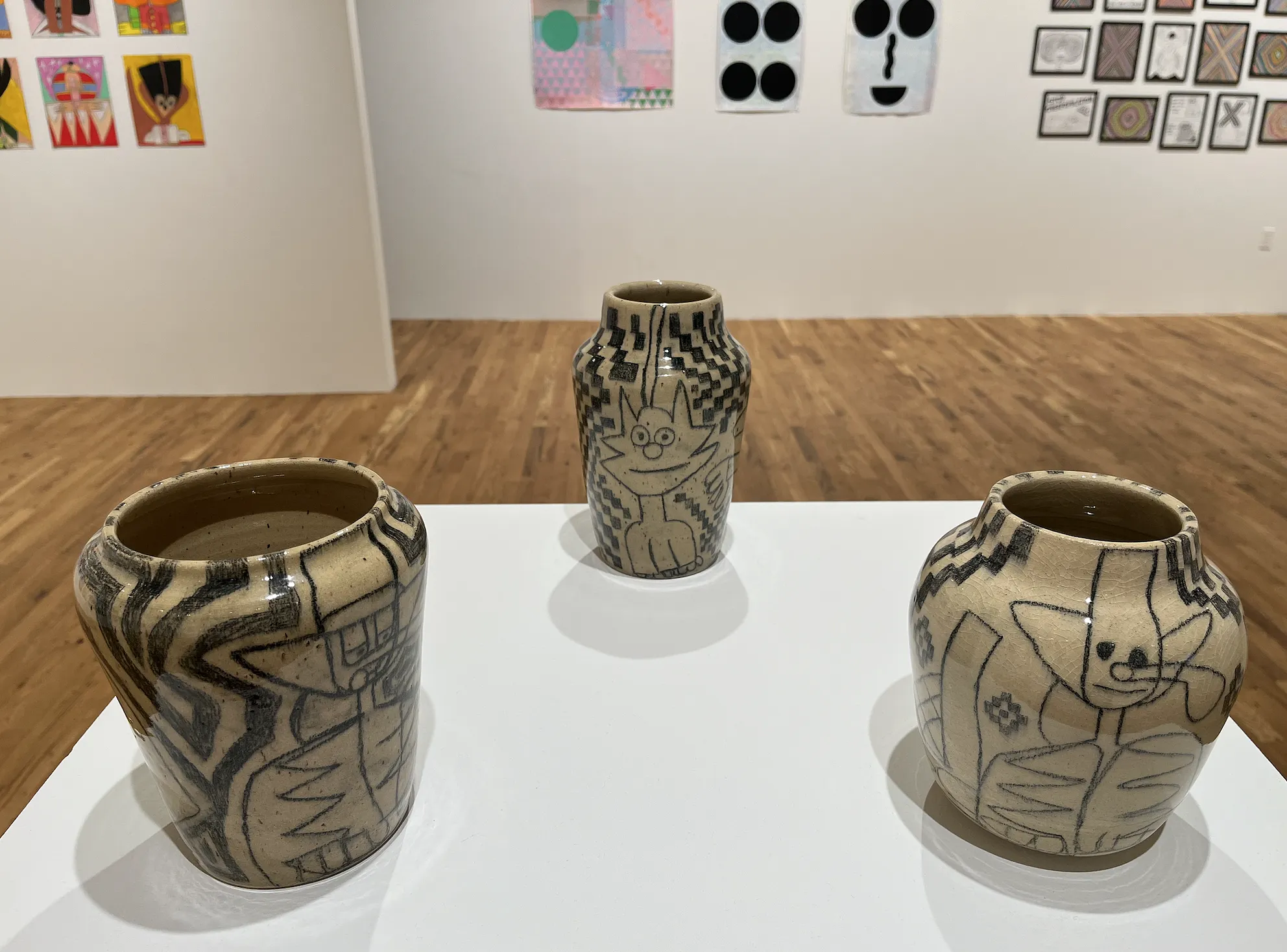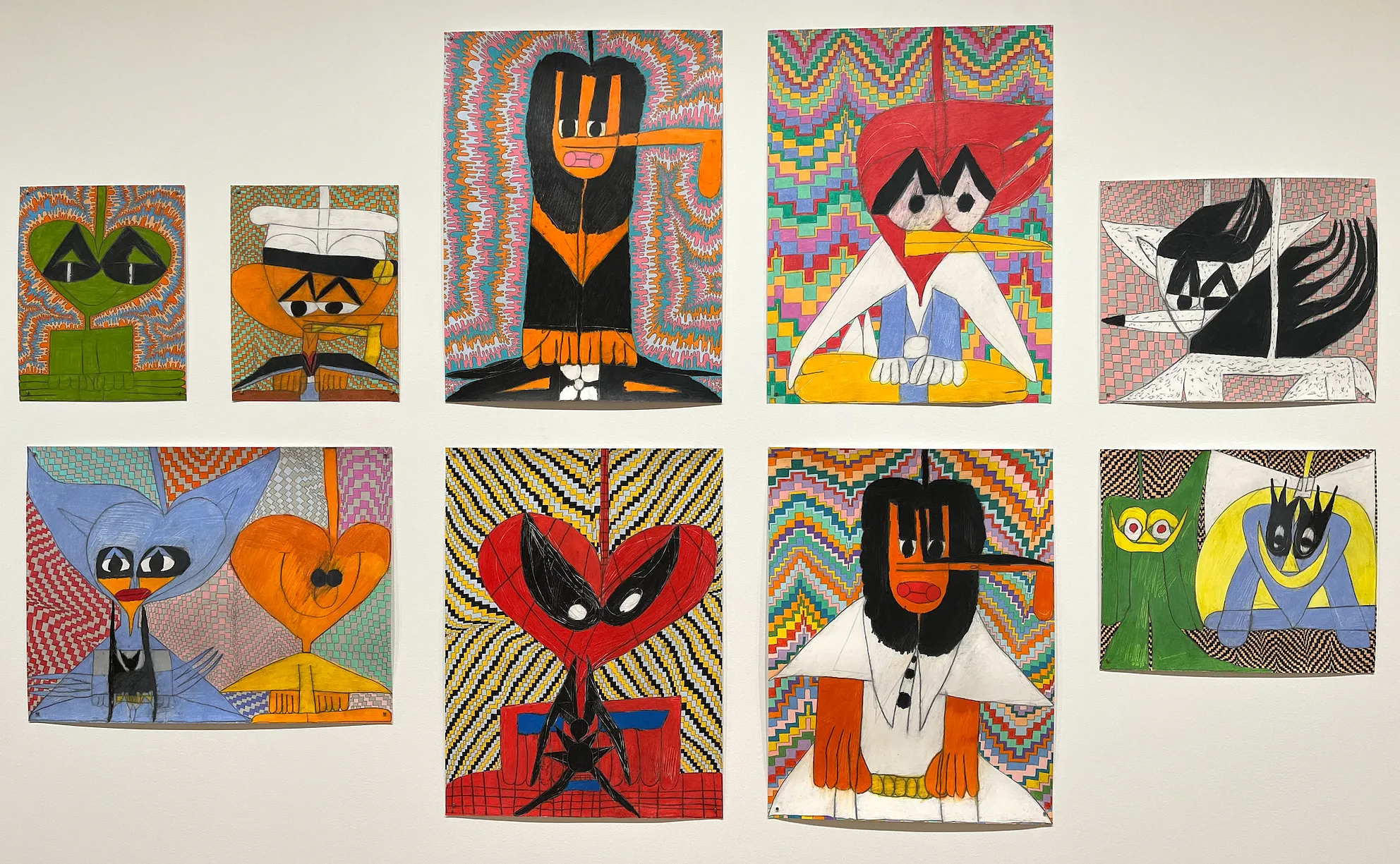E.T. And Some Bananas
Fleisher/ Ollman Gallery
915 Spring Garden St.
Philadelphia
July 24, 2024
I took in a wall of misshapen, flat figures with stone faced expressions — and recognized them as Big Birds, Garfields, superheroes and cereal box characters.
Those portraits — a series of caricatures gone wrong, if you will — are showing at the Fleisher/ Ollman Gallery, a display room dedicated to so-called “self-taught” artists, which in recent years has broadened to include artists from developmentally disabled studio programs.
When I first saw the exhibit, “E.T. And Other Bananas,” featuring art made by Philly locals Anthony Coleman and Andrew Jeffrey Wright, I thought I was facing a trope that has come to feel all too familiar in recent years: Recycling so-called “naive art” principles to pass rudimentary pop art off as high-brow bidding material.
I just know too many former liberal arts kids who started churning out easily intricate Jean-Michel Basquiat impersonations when they realized that loaded “self-taught” labeling had become a lucrative loophole career. But the current exhibit is a reminder as to why the “self-taught” genre is genuinely compelling. It highlights a perspective that inherently circumvents standard ways of operating, as opposed to one concerned with consciously forgetting or rejecting established expectations and instructions on how to make exclusive things.
In this case, visitors to the gallery get to observe a collaboration at play between Coleman — who drew the faces featured at the forefronts of most of the spotlit artworks — and his coach from Artworks/ Community Integrated Services, Wright, who adds a pixelated pattern to the backgrounds of several works while pitching in some framed cartoons to boot.
The show seems to get at, in a softly comical way, the endurance of iconography in human civilization — through, for example, positioning harsh, primary-scribbled portraits of bizarre branding creations like Angry Bird next to legendary-looking clay vases inscribed with similar cartoon deities all beside goofy sketches of energetic objects like to-go bags, sinks, Pabst beer cans, and empty pizza boxes with unfortunate captions like “When necessary, all of these can be toilets.”
Toilet humor knows no bounds. And, similarly, while the implications of certain cultural symbols are ephemeral, the fundamental features that so often define them are everlasting and translatable, including but not limited to the dramatic eyebrows and severe shapes which ultimately anthropomorphize and animate modern day marketing ploys like Count Chocula, Boo Berry, Woody Woodpecker, and Batman into muses for home-schooled students in artistic fundamentals, such as the the mid-fifties Coleman.
Rather than framing the art as familiar for its apparent childlike sensibilities, the artists are selling the pinned-up pieces as alien, naming the exhibit after both its focus on the ubiquitous, hence “bananas,” and the out-of-nowhere, hence “E.T.”

I noticed a demented rendering of the humanoid green stick Gumby, who I’ve observed popping up recently in other trippy, icon-interested exhibits across Philly. (Read about one example here.)
I asked the internet why Gumby is such a persistent figure in the perplexingly bordered world of self-taught art. I first found that Google eagerly pulls up information about Gumby’s possession of “a magical ability to shape shift and travel to any place and any time past, present or future.”
This newsletter about Gumby’s “avant-garde” beginnings recalls the character’s development as “an experiment in pure movement” where “the distraction of recognizable forms is removed and only the sensations of motion remain.”
Similarly, rather than qualifying art that bypasses illusions of depth or other techniques to simulate detailed realism as “naive,” the gallery’s bananas show proposes neurodivergent artwork as perpetually telling in their thorough immediacy, as seen through Coleman’s standoffish condensing of popular culture into focal points for Wright’s electric, motion-insistent backgrounds. Everything on display is communicated through simple shapes, bold chunks of color, and saturated style, just as its subjects are ironed down by deadpan eyes and one-dimensional detailing.
Even if many of the inspirations for Coleman’s artworks are somewhat obscure characters from generations long unknown to me, the uncanny sense of recognition brought on by the artist’s stylistic repackagings of personalities remembered out of decades worth of children’s media reminds me of the importance of observation.

We learn from regurgitating — replicating and then spitting out and then resurrecting — the persistent messaging delivered unto us through television, school, newspapers, whatever. It is always interesting to see vibrant taxonomies of the references — the animated objects and choreographed storylines — that inform our varied personhoods.
Rather than representative of some sort of arrested development case or “naive” taste and talent, the show is a visual glimpse into the pictures that have impressed upon one artist’s perspective — and a neighborly invitation into the process of one particular Philly voice that is representative of communities not frequently or thereby fairly featured in professional spaces.
While the discourse is all about attempts by the public to distance themselves from problematic artists of beloved artworks, I found myself contentedly turned around in this case: I am left wanting to learn much more about how Anthony Coleman sees the world.
NEXT:
“E.T. And Some Bananas” remains on display at the Fleisher/Ollman gallery through Aug. 16.






